Key takeaways:
- Reparations are about acknowledgment and healing, transcending mere financial aid, and involve community discussions for accountability and understanding.
- Community organizing fosters collective action and empowers individuals, highlighting the importance of storytelling and sustained engagement in movements.
- Effective organizing relies on building trust, flexible strategies, and clear communication of goals and values to inspire participation.
- Building a sustainable reparations initiative requires trust, transparency, and continuous education to ensure community members feel involved and informed.

Understanding reparations politics
Reparations politics can feel like a sprawling conversation, deeply intertwined with history and justice. I recall listening to a community leader eloquently describe how the scars of past injustices linger, affecting generations. It sparked a realization in me: how often do we overlook the enduring impacts of systemic discrimination when discussing reparations?
As I delved deeper into the concept, I found that reparations aren’t merely financial aid—they represent an acknowledgment of harm and a commitment to healing. Like when I attended a local town hall where passion filled the air; personal stories of loss and resilience reminded me that this is about restoring dignity, not just dollars. Isn’t it vital to ask ourselves how we can start meaningful conversations about accountability and responsibility?
Understanding reparations politics also requires grappling with differing opinions within communities. I’ve been moved by debates that highlight not just the need for reparative measures, but the fear surrounding them. How can we bridge these divides? The answer may lie in open discussions that foster empathy and understanding of our shared histories while considering the diverse voices that many times go unheard.
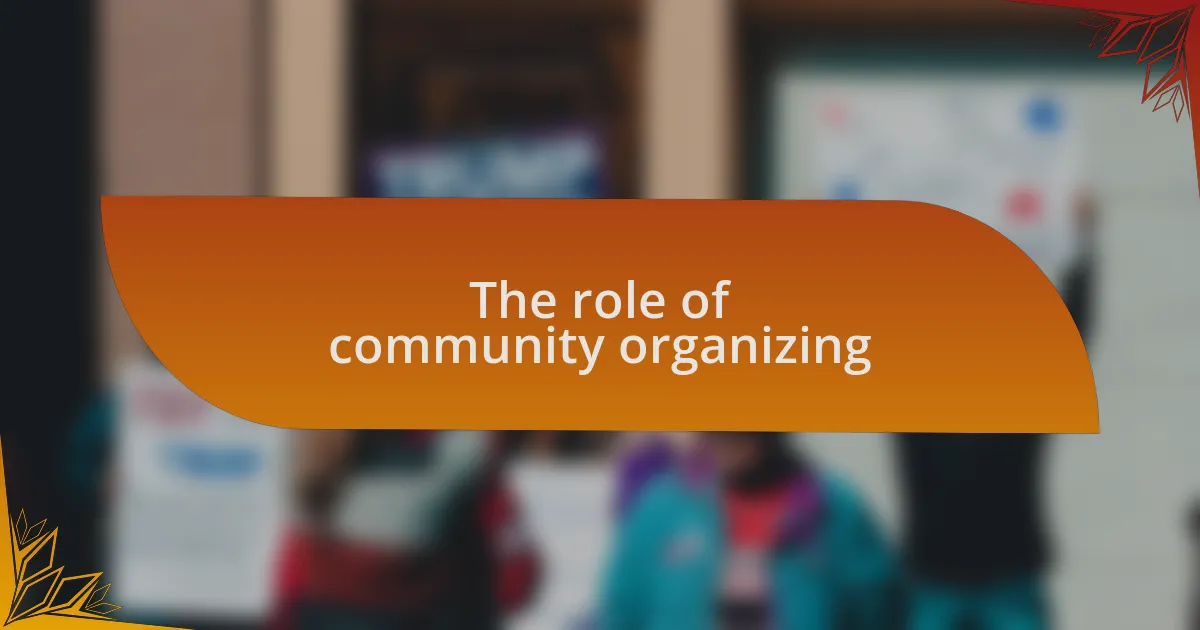
The role of community organizing
Community organizing plays a pivotal role in galvanizing collective action around reparations. I remember attending a community meeting where individuals from different backgrounds shared their stories, intertwining personal experiences with broader systemic injustices. It was a stark reminder that grassroots efforts are often the catalyst for change, sparking dialogue and commitment towards reparative justice.
Engaging with community members fosters a sense of ownership in the process of demanding reparations. In one instance, I witnessed how a neighborhood group organized a petition drive, and the excitement was palpable. It made me reflect on how empowering ordinary people helps cultivate leaders and activists who advocate for their rights. Isn’t it fascinating how these local efforts can influence larger policy discussions?
Moreover, community organizing creates an avenue for education and awareness. I recall an event where local historians shared insights on the legacy of discrimination in our area, transforming abstract ideas of reparations into tangible realities for many. How often do we overlook the significance of knowledge in this movement? This kind of awareness is essential for not just mobilizing support but also ensuring that conversations around reparations are grounded in history, context, and shared understanding.
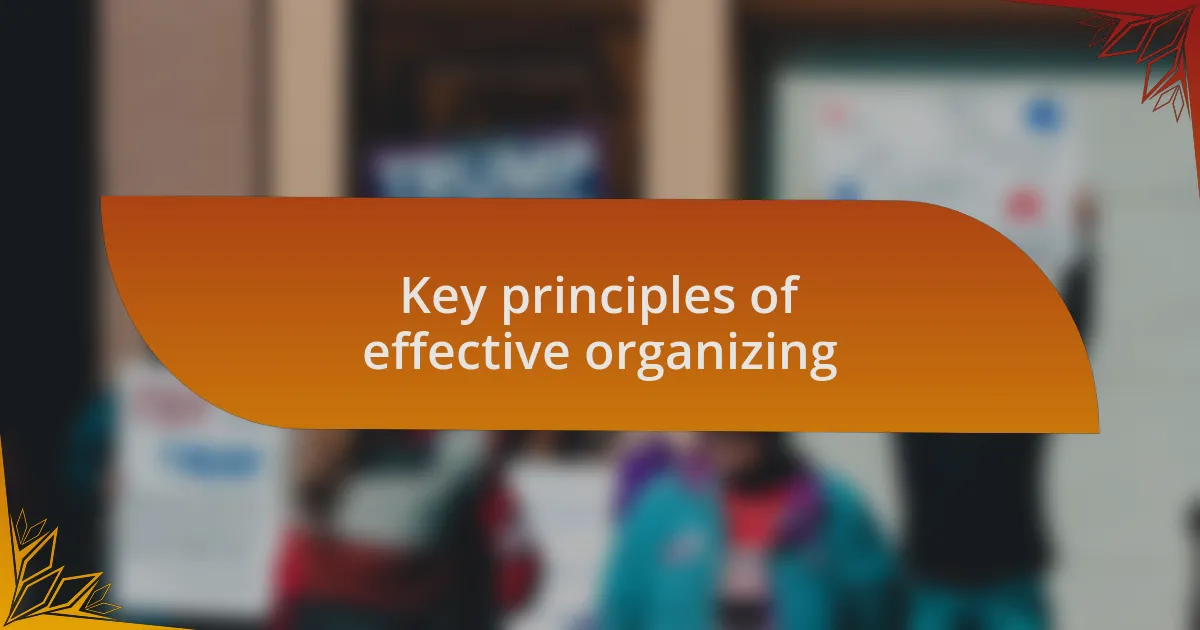
Key principles of effective organizing
One key principle of effective organizing is building authentic relationships within the community. I recall a time when I attended a grassroots planning session where organizers emphasized the importance of trust. It struck me how crucial it is to truly listen to people’s experiences and validate their feelings. When community members know they are seen and heard, they are more likely to engage and contribute to collective efforts.
Another vital aspect is the flexibility to adapt strategies based on community feedback and changing circumstances. I remember participating in a strategy meeting that allowed for open discussions, leading to innovative solutions we hadn’t considered. It highlighted to me that being open to new ideas can spark creativity and resilience in a movement. How might our approach evolve if we remain receptive to the needs and suggestions of those we aim to serve?
Finally, effective organizing necessitates clear communication of goals and values. I’ll never forget an instance where a campaign leader articulated our collective vision so passionately that it ignited the room. It reminded me how important it is to create a shared language around our mission. How can we expect people to rally together if they don’t understand the principles guiding our work? Clear communication ensures that every participant grasps not just the ‘what’ but the ‘why’ behind our actions.
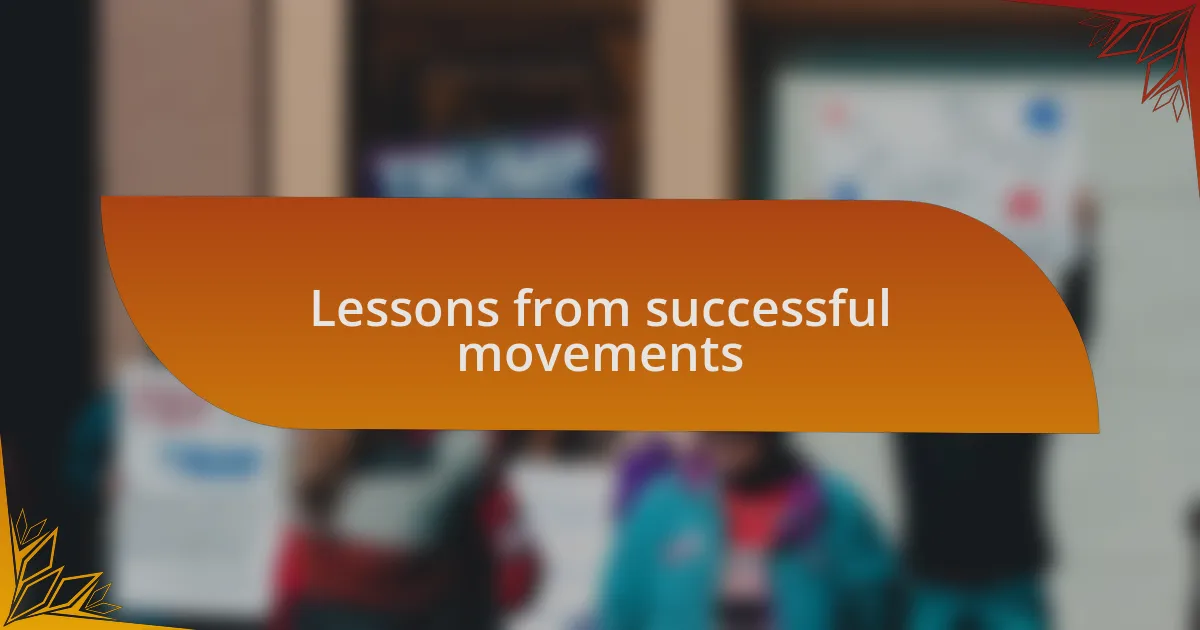
Lessons from successful movements
It’s fascinating how successful movements demonstrate the power of unity in diversity. I remember participating in a coalition where different groups came together, each bringing unique perspectives to the table. Witnessing how individuals with various backgrounds collaborated toward a common goal taught me that embracing our differences can strengthen our collective voice. Have you ever experienced the magic of diverse perspectives working toward a single purpose? It’s transformative.
I learned that the most successful movements are often driven by compelling storytelling. At one event, a participant shared their personal story of struggle, and I was struck by how it resonated with everyone there. This simple act of vulnerability can rally people and shift the narrative. How can we harness storytelling to inspire action in our communities? It’s a tool that transcends mere facts, creating emotional connections that bring others alongside us.
Additionally, I’ve seen that sustained engagement is key. In a recent local initiative, we set up regular follow-up meetings to maintain momentum. It made a significant difference. I realized that ongoing involvement creates ownership among participants, fostering a deeper commitment to the cause. How might we cultivate this sense of ownership in our movements? Regular touchpoints can be more than just meetings; they’re opportunities to reignite passion and solidarity.
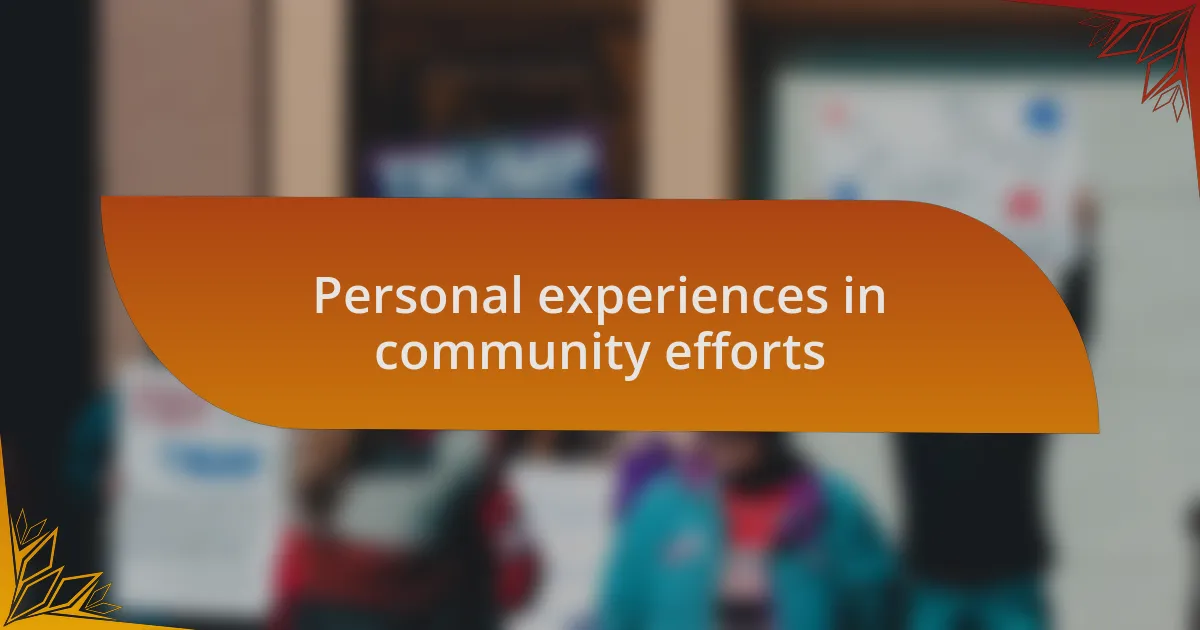
Personal experiences in community efforts
When I joined a community clean-up initiative last summer, the energy was palpable. Seeing my neighbors—some I’d known for years but never truly interacted with—come together with tools and trash bags was eye-opening. It struck me how a common purpose could dissolve barriers; we bonded over shared laughs and the commitment to improve our neighborhood. Have you ever realized how a simple act, like picking up litter, can transform not just a space, but the sense of community itself?
In another effort, I participated in a dialogue circle aimed at addressing local injustices. I remember one session vividly—someone shared their experience with housing discrimination. The room grew quiet, and I could feel the weight of their words. It hit home for me, illustrating how personal experiences can spark empathy and drive change. Have you ever felt a shift in perspective just by listening to someone’s story? It’s a reminder that the heart of community efforts often lies in these shared experiences, creating a bridge to understanding.
A memorable moment for me was during a fundraising event for a local arts program. The passion in the room was infectious as we collaborated on creative ways to engage our community, from art auctions to talent showcases. I learned that motivation often flourishes within a space that encourages creativity and participation. How often do we allow ourselves to think outside the box? After that experience, I realized how important it is to foster an environment where everyone feels empowered to contribute their ideas, no matter how unconventional they may seem.
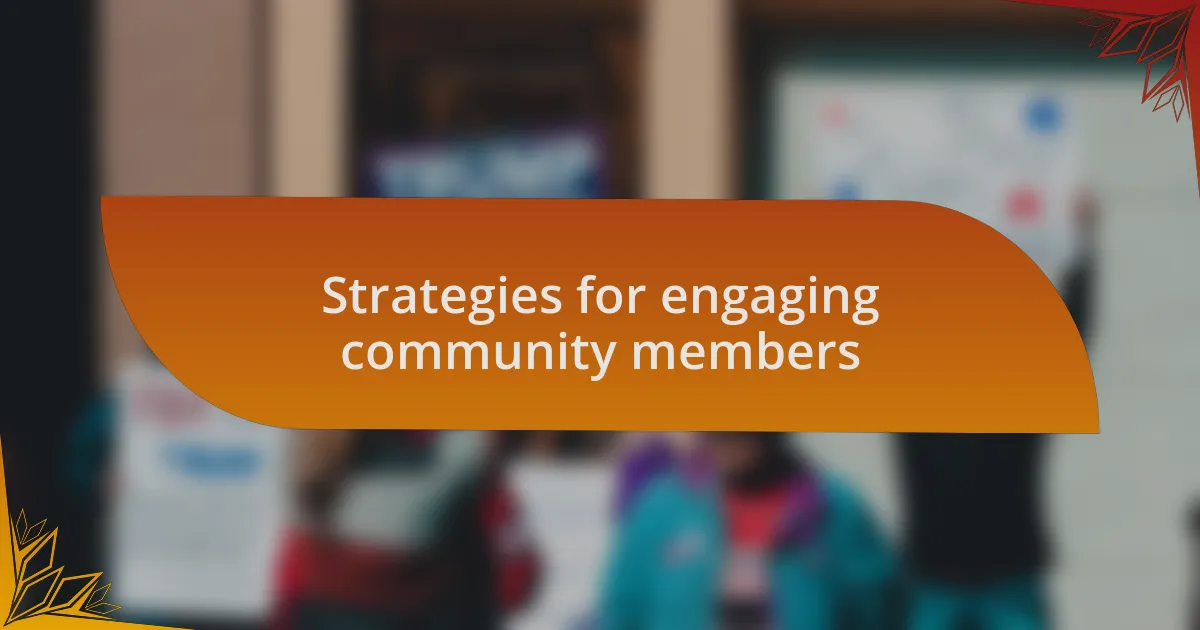
Strategies for engaging community members
Engaging community members requires listening first and foremost. I recall a meeting where the agenda was set based on what we thought were the community’s most pressing issues. However, as discussions unfolded, we quickly realized we missed the mark. A simple survey or informal conversations could have illuminated real concerns—like job opportunities and education—that our neighbors hold dear. Have you ever noticed how important it is to truly listen before taking action?
Another effective strategy is to invite members to lead initiatives. I remember when we organized a workshop where anyone could offer a skill—be it cooking, carpentry, or even gardening. This approach not only showcased the diversity within our community but also empowered individuals. Have you experienced the surge in enthusiasm when someone stepped into a leadership role? It made me appreciate the wealth of knowledge in our community, reminding me that every member has something unique to contribute.
Creating a regular, open forum can also spark engagement. In one instance, we launched a monthly potluck where discussions flowed as freely as the food. The informal setting allowed people to connect on a personal level, with conversations about neighborhood safety mingling with stories of culture and family. Isn’t it fascinating how breaking bread can break barriers? This experience taught me that routine gatherings can transform acquaintances into allies, paving the way for more substantial community involvement.
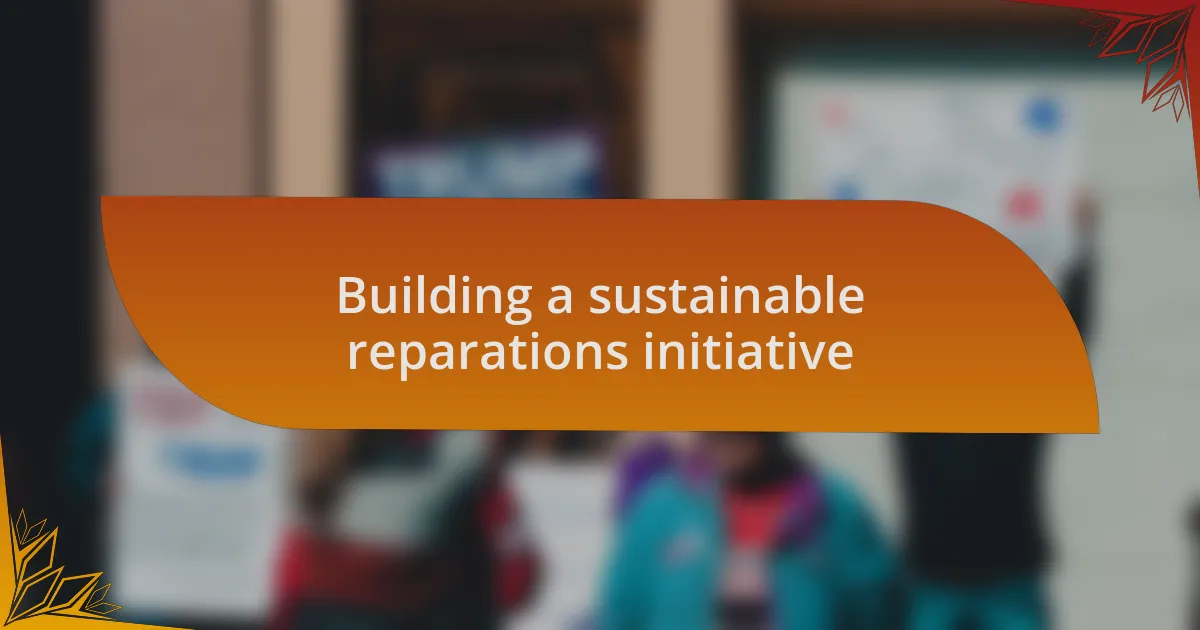
Building a sustainable reparations initiative
Building a sustainable reparations initiative starts by fostering a sense of trust and ownership among community members. In my experience, one of the most effective approaches was setting up a community advisory board, comprised of individuals who genuinely understood the lived experiences of those affected by historical injustices. This board didn’t just meet occasionally; they became the backbone of our planning process, generating ideas and ensuring that every voice was heard. Can you imagine how empowering it is for community members to see their perspectives reflected in an initiative that aims to address their needs?
Moreover, I’ve learned that transparency is crucial. During a planning session for a local reparations initiative, I remember clearly sharing our budget and potential funding sources with attendees. Initially, there were skeptics, but when they saw our commitment to openness, it transformed the atmosphere. Suddenly, more people felt invested in the discussions. Have you ever felt that shift in energy when people realize they’re included in a decision-making process? That experience taught me how critical it is to create an environment where everyone feels their input matters.
Sustainability also hinges on continuous education and awareness-building within the community. I recall hosting a series of workshops that focused not just on reparations but also on the interconnectedness of systemic issues like housing, healthcare, and employment. The conversations that emerged were eye-opening, with participants connecting their personal stories to larger historical narratives. This experience reinforced my belief that knowledge can be a powerful tool for fostering a more informed and engaged community. How can we expect progress if we don’t empower each other with understanding?